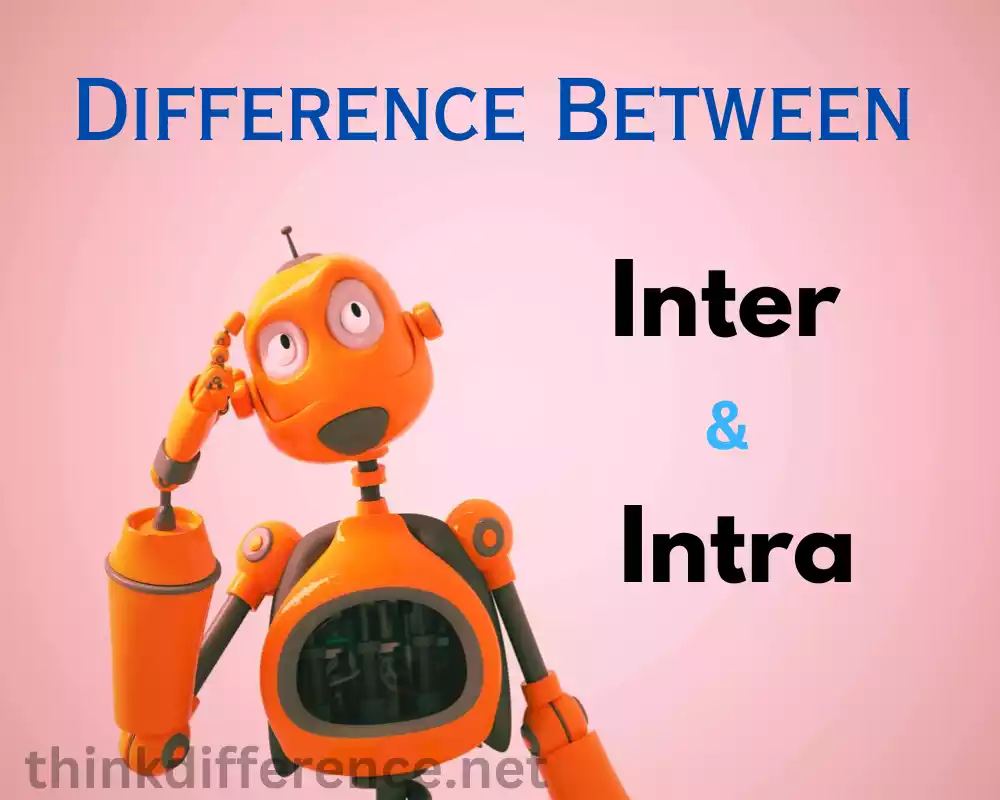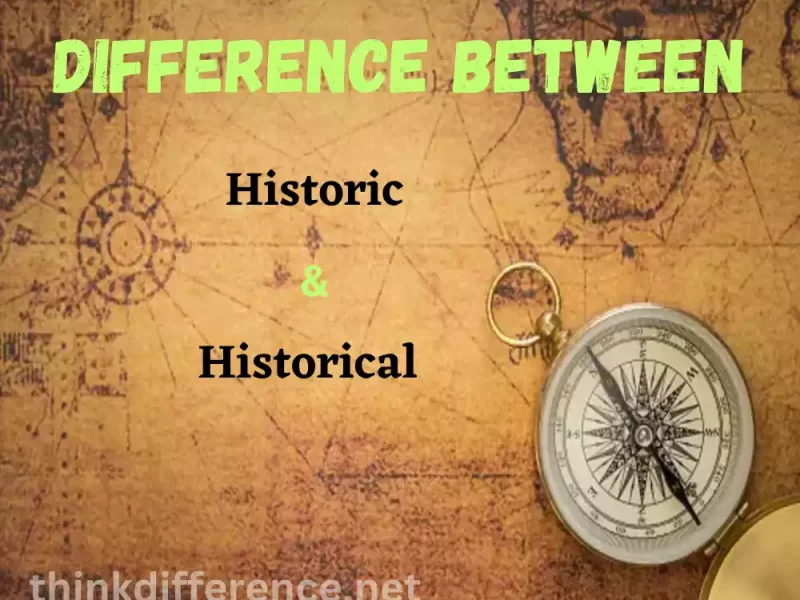Inter and Intra which provide depth and meaning to various concepts. Yet do we fully appreciate their significance? In this article, we’ll look into their definition, usages, and functions within various aspects of daily living – giving a deeper insight into these prefixes’ significance in everyday language.

What is Inter?
Inter refers to interactions, relationships or activities that occur between different entities or groups. It involves the exchange, communication or connection between distinct individuals, organizations or nations. Inter can refer to an array of disciplines and contexts, spanning interpersonal communications, international relations or interdisciplinarity studies.
Inter-personal communication refers to any form of conversation occurring among two or more parties. It involves the exchange of ideas, information and emotions between people, facilitating understanding, collaboration and social connections.
In international relations, inter refers to interactions and relationships between different nations or states. It involves diplomatic, political, economic and social exchanges between countries, aiming to establish peaceful cooperation, resolve conflicts and promote mutual benefits.
In interdisciplinary studies, inter refers to the integration and collaboration between multiple academic disciplines. It involves combining knowledge, methodologies and perspectives from different fields to address complex problems, foster innovation and generate holistic insights.
Inter highlights the importance of interactions and connections between different entities, fostering cooperation, understanding and exchange in various contexts.
Here are some common types:
-
- Interpersonal: Interpersonal interactions occur between individuals. It involves communication, exchange of ideas, emotions, and building relationships on a personal level. Examples include conversations between friends, family members, colleagues or romantic partners.
- International: International interactions occur between different nations or countries. It encompasses diplomatic relations, trade agreements, cultural exchanges and collaborations on a global scale. Examples include international treaties, negotiations and international organizations like the United Nations.
- Interdisciplinary: Interdisciplinary interactions occur between different academic disciplines. It involves combining knowledge, methods and perspectives from multiple fields to address complex problems or research questions. Examples include collaborations between scientists, engineers, social scientists and humanities scholars to solve interdisciplinary challenges.
- Intergenerational: Intergenerational interactions occur between different generations. It involves communication, exchange of experiences and understanding between people of different age groups. Examples include interactions between parents and children, mentorship programs or initiatives aimed at bridging the generation gap.
- Interdepartmental: Interdepartmental interactions occur within an organization or institution, between different departments or divisions. It involves collaboration, coordination and communication across various units to achieve common goals. Examples include cross-departmental meetings, joint projects and information sharing between teams.
- Interorganizational: Interorganizational interactions occur between different organizations or companies. It involves collaborations, partnerships or business transactions between separate entities. Examples include strategic alliances, joint ventures or supplier-customer relationships.
- Interstate: Interstate interactions occur between different states or regions within a country. It involves communication, coordination and governance between regional entities. Examples include intergovernmental agreements, policies or economic collaborations between states.
These are just a few examples of the types of “Inter” that describe different forms of interactions between entities. Each type has its own characteristics, dynamics and significance within specific contexts.
Importance of Inter
The importance of Inter, which refers to interactions between different entities or groups, is significant in various contexts.
Here are some key reasons why Inter is important:
- Enhancing cultural exchange and increasing diversity: Interactions among individuals or communities across nations helps facilitate sharing of beliefs, perspectives and viewpoints while encouraging diversity of culture as well as creating mutual understanding to break down stigmas and stereotypes.
- Enables cooperation and collaboration on a global scale: Assist in global collaboration and cooperation between nations as well as individuals, organizations and groups enables collaboration in areas like trade as well as science, technology, security, knowledge-sharing and skill sharing for solving common challenges or meeting objectives.
- Promotes understanding and tolerance: Interactions among diverse groups foster empathy, understanding and respect for other perspectives, cultures and beliefs; foster dialogue to reduce conflict; promote peace and foster harmony within societies that are multicultural.
- Drives innovation and creativity: Innovation and creativity are at the core of success in any discipline or field of study, spurred on by interactions across diverse spheres and subjects of inquiry, opening the way to novel perspectives, methodologies, methods of working that lead to breakthrough innovations across sciences, arts and technologies.
- Facilitates Prosperity and Economic: Growth Interactions such as trading, investing and collaborations are the backbone of economic expansion and an increase in prosperity. They open markets, create innovation possibilities for development of goods or services cross borders as well as exchange of knowledge across borders.
- Solutions to global challenges: Global issues like poverty, climate change and pandemics require global cooperation and collective action from different individuals, organizations and countries in order to be efficiently tackled. Through interactions among governments as well as individual citizens or organizations within them we can tackle complex problems efficiently.
- Interactions Build Partnerships and Networks: Interactions can form partnerships, networks and alliances which allow synergies and the collaborative solution of issues by pooling expertise, resources and capabilities towards reaching mutual goals.
- Provides opportunities for personal and professional development: Engaging with various people and groups provides ample chances to expand horizons while developing essential skills such as communication, collaboration and intercultural competency.
Inter value lies in its capacity to connect individuals, communities and nations and foster collaboration, understanding and advancement. Inter empowers communities by spurring forward innovation more rapidly while helping us address global issues more efficiently.
What is Intra?
Intra refers to interactions, relationships or activities that occur within a single entity or group. It focuses on the internal dynamics, processes and relationships within a particular entity, rather than interactions between different entities.
Here are some common examples of Intra:
-
- Intrapersonal: Intrapersonal interactions occur within an individual’s own mind or self. Self-reflection, dialogue with oneself and contemplation all form part of this practice. Examples may include self-analysis, decision making processes or self motivation techniques.
- Intra-team: Intra-team interactions occur within a specific team or group of individuals working towards a common goal. It involves collaboration, coordination and communication within the team. Examples include team meetings, brainstorming sessions or sharing of tasks and responsibilities among team members.
- Intra-organizational: Intra-organizational interactions occur within an organization or company. It involves the internal workings, processes and relationships within the organization. Examples include internal communications, organizational culture, policies and procedures and interactions between different departments or divisions.
- Intra-family: Intra-family interactions occur within a family unit. It involves communication, relationships and dynamics among family members. Examples include family discussions, sharing of responsibilities or conflicts resolution within the family.
- Intra-personnel: Interpersonal interactions within an organization occur between various individuals or groups within it. It involves interactions, relationships and collaborations within a specific workforce or personnel category. Examples include interactions between employees of a specific department or interactions within a specific role or level in an organization.
- Intra-community: Intra-community interactions occur within a specific community or group of people sharing common characteristics or interests. It involves communication, cooperation and engagement within the community. Examples include community meetings, events or collaborations among community members.
These examples illustrate the concept of Intra, which emphasizes the interactions, relationships and dynamics within a single entity or group. Understanding the dynamics of Intra is crucial for effective communication, collaboration and coordination within specific contexts.
Importance of Intra
The importance of Intra, which refers to interactions and relationships within a single entity or group, is significant in various contexts.

Here are some key reasons why Intra is important:
- Self-awareness and personal growth: Intra activities self-reflection and self-analysis, promote self-awareness and personal development. They allow individuals to understand their strengths, weaknesses, values and aspirations, leading to personal growth and improvement.
- Strengthening teamwork and collaboration: Intra-team interactions within a specific group or team promote collaboration, coordination and effective teamwork. By understanding each other’s strengths, weaknesses and communication styles, team members can work together more efficiently and achieve shared goals.
- Optimizing organizational efficiency: Intra-organizational interactions focus on the internal dynamics, processes and relationships within an organization. By fostering effective communication, coordination and cooperation among different departments or teams, intra activities contribute to enhancing overall organizational efficiency and productivity.
- Conflict resolution and improved relationships: Intra activities provide opportunities for conflict resolution and improved relationships within a group or organization. By addressing issues, fostering open communication and understanding diverse perspectives, intra activities contribute to creating a positive and harmonious work environment.
- Sharing of knowledge and expertise: Intra activities allow for the sharing of knowledge, expertise and best practices within a group or organization. It enables the transfer of valuable insights, experiences and skills among members, leading to collective learning and continuous improvement.
- Alignment of goals and values: Intra interactions help align the goals, values and vision within a group or organization. By facilitating discussions, clarifying expectations and fostering a shared understanding, intra activities ensure that all members are working towards a common purpose and shared values.
- Employee engagement and satisfaction: Intra activities that focus on employee well-being, recognition and development contribute to higher employee engagement and satisfaction. When individuals feel valued, supported and connected within their organization, they are more likely to be motivated, productive and committed.
- Organizational culture and identity: Intra activities play a crucial role in shaping organizational culture and identity. They define the norms, values and shared beliefs within a group or organization, creating a sense of belonging and a positive work environment.
The importance of Intra lies in its ability to foster personal growth, strengthen teamwork, optimize organizational processes, and create a positive and productive work environment. By focusing on internal interactions and relationships, Intra activities contribute to the success and well-being of individuals, teams and organizations.
Differences between Inter and Intra
The terms “Inter” and “Intra” have distinct meanings and are used to highlight different types of interactions or relationships.
Here are the key differences between Inter and Intra:
- Definition:
- Inter: Refers to interactions, relationships or activities that occur between different entities or groups. It emphasizes connections, exchanges or communication between separate entities.
- Intra: Refers to interactions, relationships or activities that occur within a single entity or group. It emphasizes internal dynamics, processes or relationships within a specific entity.
- Scope:
- Inter: Involves interactions between different entities, such as individuals, organizations or nations.
- Intra: Focuses on interactions within a single entity or group, such as within an individual, a team or an organization.
- Focus:
- Inter: Emphasizes the relationships, connections or collaborations between different entities. It looks outward and considers the dynamics between separate entities.
- Intra: Emphasizes the internal dynamics, processes or relationships within a single entity or group. It looks inward and considers the dynamics within the entity.
- Examples:
- Inter: Examples of Inter include interpersonal communication, international relations or interdisciplinary studies, where interactions occur between different individuals, nations or disciplines.
- Intra: Examples of Intra include intrapersonal communication, intra-team dynamics or intra-organizational processes, where interactions occur within an individual’s mind, a specific team or an organization.
- Importance and Impacts:
- Inter: Interactions between different entities promote global cooperation, understanding and cultural exchange. They facilitate collaboration on a larger scale, enable diversity and foster relationships between different groups.
- Intra: Interactions within a single entity or group facilitate personal growth, teamwork and organizational efficiency. They enhance self-awareness, strengthen relationships within the entity and optimize internal processes.
Understanding the differences between Inter and Intra is crucial for recognizing the context and dynamics of interactions, whether they occur between separate entities or within a single entity. Both concepts play important roles in various contexts and have distinct implications for relationships, collaborations and overall effectiveness.
Inter and Intra in Relationships
In the context of relationships, both Inter and Intra dynamics play significant roles in shaping the interactions and overall dynamics.
Let’s explore the importance of both Inter and Intra in relationships:
Inter in Relationships:
-
- Broadening perspectives: Interactions with people outside the relationship, such as friends, family and acquaintances, bring diverse perspectives and experiences. These external interactions can broaden one’s worldview, challenge assumptions and contribute to personal and relational growth.
- Social support and networks: Interactions with others provide social support, a sense of community, and opportunities for shared activities. Friendships, support networks and social connections outside the primary relationship can enhance well-being and resilience.
- Relationship skills development: Interactions with others outside of one’s own relationship provide the chance to hone and develop skills related to communicating, conflict resolution and empathy. Learning from different individuals and relationship dynamics can improve one’s abilities within the primary relationship.
- Healthy boundaries: Interactions with others can help establish and maintain healthy boundaries within the relationship. Developing friendships and maintaining individual interests and social connections outside the partnership can contribute to a balanced and fulfilling relationship.
Intra in Relationships:
-
- Self-reflection and self-awareness: Intra activities introspection and self-analysis, allow individuals to understand their own needs, emotions and desires within the relationship. This self-awareness can lead to improved communication and better self-expression to meet personal needs.
- Emotional regulation: Intra activities promote emotional regulation and self-management. Understanding one’s emotions and creating strategies for self-care are keys to creating stronger relationships.
- Identifying personal values and boundaries: Intra exploration helps individuals identify their values, beliefs and boundaries, which are essential in establishing healthy relationship dynamics. Clarifying personal boundaries and communicating them effectively can foster respect and mutual understanding within the partnership.
- Personal growth and fulfillment: Intra activities, such as pursuing individual goals, hobbies and self-care, contribute to personal growth and fulfillment. Focusing on their personal wellbeing and development can bring inner satisfaction and joy into their relationships.
It is important to strike a balance between Inter and Intra dynamics in relationships. While external interactions broaden perspectives and offer support, internal self-reflection and personal growth are equally crucial for maintaining a healthy and fulfilling partnership. Both Inter and Intra aspects contribute to the overall strength and well-being of the relationship.
Inter and Intra in Business
Inter and Intra dynamics play important roles in the context of business. Here’s how Inter and Intra are relevant in the business environment:
Inter in Business:
-
- Collaboration and partnerships: Interactions between different businesses, organizations or departments facilitate collaboration and partnerships. Through strategic alliances, joint ventures or outsourcing arrangements, businesses can leverage each other’s strengths, share resources and pursue mutually beneficial goals.
- Networking and market expansion: Interactions with customers, suppliers, industry peers and stakeholders enable businesses to build networks, expand their market reach and explore new opportunities. Engaging in trade shows, industry events or professional networks can lead to valuable connections and business growth.
- Knowledge exchange and innovation: Interactions with experts, researchers, and professionals from diverse fields contribute to knowledge exchange and foster innovation. Collaborative projects, research partnerships or participation in industry forums can spark new ideas, technologies and approaches that drive business advancement.
- Competitive advantage and differentiation: Interactions with competitors provide insights into market trends, industry benchmarks and competitive strategies. By monitoring and learning from competitors, businesses can adapt, differentiate themselves and gain a competitive edge.
Intra in Business:
-
- Internal communication and teamwork: Intra activities within an organization promote effective internal communication, coordination and teamwork. Clear channels of communication, collaborative workflows and a positive organizational culture contribute to increased productivity, efficiency and employee satisfaction.
- Organizational development and growth: Intra activities, such as strategic planning, talent development and process improvement, contribute to organizational development and growth. By focusing on internal operations, businesses can optimize processes, enhance performance and foster innovation.
- Employee engagement and retention: Intra activities that prioritize employee well-being, recognition and professional growth contribute to higher employee engagement and retention. Employees who feel valued and appreciated will likely remain loyal and contribute significantly towards ensuring the success of the business.
- Organizational culture and values: Intra interactions shape the organizational culture, values and identity. Establishing a positive work environment, fostering collaboration and aligning employees around shared goals and values contribute to a strong organizational culture that attracts talent and supports business objectives.
Both Inter and Intra dynamics are crucial in the business context. Interactions with external entities drive collaboration, innovation and market expansion, while Intra activities within the organization foster effective internal communication, teamwork and organizational development. Striking a balance between Inter and Intra dynamics can contribute to the overall success and growth of a business.
Inter and Intra in Communication
Inter and Intra dynamics are relevant in the context of communication. Here’s how Inter and Intra play roles in communication:
Inter in Communication:
-
- Interpersonal communication: Interactions between individuals from different backgrounds, cultures or perspectives contribute to interpersonal communication. It involves the exchange of ideas, emotions and information between individuals, fostering understanding, empathy and building relationships.
- Intercultural communication: Interactions between individuals from different cultures require intercultural communication skills. It involves understanding and adapting to cultural differences, navigating language barriers and fostering effective communication across diverse cultural contexts.
- Public speaking and presentations: Interactions between a speaker and an audience involve intercommunication. Public speaking and presentations require effective delivery, engaging with the audience and conveying messages that resonate with diverse listeners.
- Mass communication: Interactions between the sender and a large audience occur in mass communication. Public relations (PR) refers to communicating through various media platforms – radio, TV, print media or digital technologies – with the purpose of disseminating information, altering opinions or reaching a broader public audience.
Intra in Communication:
-
- Intrapersonal communication: Intra activities involve communication with oneself, often referred to as self-talk or internal dialogue. Meditation plays an integral role in self-reflection, decision-making and expression – essential elements that contribute to personal development and self-awareness.
- Self-expression and self-confidence: Intra activities foster self-expression, allowing individuals to articulate their thoughts, feelings and opinions with clarity and confidence. It involves understanding one’s own perspectives, emotions and needs, and effectively conveying them to others.
- Active listening and self-awareness: Intra activities help individuals develop active listening skills and self-awareness. Understanding one’s listening patterns, biases and nonverbal cues contributes to effective communication and building stronger connections with others.
- Writing and self-editing: Intra activities play a role in written communication. Writing involves organizing thoughts, choosing words and editing content to ensure clarity, coherence and effective communication of ideas.
Both Inter and Intra dynamics are essential for effective communication. Inter actions involve interactions with others, fostering understanding, building relationships and engaging diverse audiences. At Intra, activities focus on self-reflection and expression as well as increasing self-awareness. Both are vital aspects of effective personal growth and expression. Striking a balance between Inter and Intra dynamics enhances communication skills, promotes understanding and fosters meaningful connections with others.
Inter and Intra in Networking
Inter and Intra dynamics are relevant in the context of networking. Here’s how Inter and Intra play roles in networking:
Inter in Networking:
-
- Building external connections: Interactions with individuals and professionals outside your immediate circle enable you to build a broader network. Engaging with people from diverse backgrounds, industries and expertise expands your opportunities for collaboration, mentorship and learning.
- Expanding industry reach: Interactions with professionals in your industry or related fields help you stay updated on industry trends, market insights and emerging opportunities. Engaging in industry events, conferences or online communities facilitates connections and builds relationships with key players in your field.
- Seeking new business opportunities: Interactions with potential clients, customers, or business partners allow you to explore new business opportunities. Networking events, business meetings or introductions through mutual connections can lead to collaborations, partnerships or client acquisitions.
- Exchanging knowledge and expertise: Interactions with professionals from different industries or backgrounds promote knowledge sharing and exchange of expertise. Engaging in discussions, attending seminars or participating in online forums enables you to learn from others, gain insights and broaden your perspectives.
Intra in Networking:
-
- Building internal connections: Intra activities involve networking within your own organization or immediate professional circle. Building connections with colleagues, superiors or subordinates fosters collaboration, knowledge sharing and professional growth within your current environment.
- Leveraging existing relationships: Intra activities emphasize nurturing and deepening existing connections. Maintaining strong relationships with mentors, colleagues or former clients/customers can lead to referrals, recommendations and new opportunities within your existing network.
- Internal knowledge sharing: Intra activities involve sharing knowledge, expertise and best practices within your organization. Participating in internal meetings, workshops or mentorship programs enables you to contribute to the growth and development of your colleagues while strengthening relationships.
- Cross-functional collaboration: Intra activities promote collaboration across different departments or teams within your organization. Engaging with colleagues from diverse backgrounds and skill sets allows you to leverage their expertise, foster teamwork and create a supportive work environment.
Both Inter and Intra dynamics are important for effective networking. Inter actions involve reaching out and connecting with individuals outside your immediate circle, expanding your network, and exploring new opportunities. Intra activities involve nurturing relationships within your existing network, sharing knowledge within your organization and fostering collaboration. By balancing both Inter and Intra dynamics, you can build a strong and diverse network that supports your professional growth and opens doors to new possibilities.
Inter and Intra in Technology

Inter and Intra dynamics are relevant in the context of technology. Here’s how Inter and Intra play roles in the field of technology:
Inter in Technology:
-
- Interconnectivity: Interactions between different technological systems and devices enable interconnectivity. This allows for the seamless exchange of data, communication and collaboration across networks, facilitating efficient information flow and enhancing productivity.
- Interoperability: Interactions between different software applications, platforms or devices require interoperability. It ensures that different technologies can work together and exchange data effectively, enabling seamless integration and providing users with a unified experience.
- Internet of Things (IoT): Interactions among wireless devices and sensors form the core of IoT. These interactions allow analysis, collection and sharing of data among devices for automaton systems in manufacturing, transportation and healthcare as well as advanced systems utilizing this data for automation purposes.
- Collaborative technology development: Interactions between technology developers, researchers and industry professionals drive collaborative technology development. Through partnerships, open-source initiatives or industry consortia, different entities can come together to pool resources, share expertise and collectively advance technology innovation.
Intra in Technology:
-
- Intra-system communication: Intra activities involve communication within a single technological system or device. This includes internal data transfer, control mechanisms and coordination between different components within a system, ensuring its proper functioning and efficient operation.
- Intra-device connectivity: Intra activities enable connectivity and communication between different components or modules within a single device. This allows for the seamless operation and interaction of different hardware and software elements within the device.
- System optimization and performance: Intra activities focus on optimizing the performance of a single technological system or device. This includes internal optimization, resource allocation and fine-tuning of components to enhance efficiency, speed and system performance.
- Security and privacy: Intra activities involve securing and protecting the internal components and data within a technological system. Implement measures, like encryption and access control as well as data segregation to safeguard security, integrity and confidentiality within a system.
Both Inter and Intra dynamics are crucial in the field of technology. Interactions between different technologies enable connectivity, interoperability and collaborative development, driving innovation and expanding possibilities. Intra activities focus on the internal functioning, optimization and security of technological systems, ensuring their efficiency, reliability and protection. By considering both Inter and Intra aspects, technology can be effectively developed, integrated and utilized to meet the diverse needs of individuals, businesses and society.
Inter and Intra in Education
Inter and Intra dynamics are relevant in the context of education. Here’s how Inter and Intra play roles in the field of education:
Inter in Education:
-
- Collaborative learning: Interactions among students, teachers and peers foster collaborative learning. Group discussions, project work and peer feedback promote active engagement, diverse perspectives and the exchange of knowledge and ideas.
- Cultural diversity and global perspectives: Interactions with students from different cultures and backgrounds expose individuals to diverse perspectives, promoting cultural understanding and global awareness. International student exchange programs, multicultural classrooms and online collaborations enhance intercultural competence and broaden horizons.
- Professional development and networking: Interactions with educators, experts and professionals outside the classroom contribute to professional development. Engaging in conferences, workshops or online communities allows educators to exchange ideas, gain insights and expand their professional networks.
- Partnerships and community engagement: Interactions between educational institutions, businesses and community organizations create partnerships that enrich the learning experience. Collaborative projects, internships programs provide students with real-world experiences and connections to the broader community.
Intra in Education:
-
- Self-directed learning: Intra activities promote self-directed learning, empowering individuals to take ownership of their educational journey. Self-study, research and reflection provide students with tools for setting goals, exploring interests and developing the ability to think critically.
- Metacognition and self-assessment: Intra activities involve metacognition, which is the awareness and understanding of one’s own learning processes. Self-assessment tools enable students to assess their progress, identify areas for development and create plans to address them.
- Personalized learning: Intra activities support personalized learning approaches, where educational content and pace are tailored to individual needs. Adaptive learning platforms, self-paced modules or individualized projects allow students to learn at their own pace and focus on their specific interests.
- Emotional well-being and self-care: Intra activities prioritize emotional well-being and self-care within the educational environment. Developing emotional intelligence, stress management techniques and promoting a positive classroom climate contribute to students’ overall well-being and academic success.
Both Inter and Intra dynamics are important in education. Interactions with others foster collaboration, cultural diversity and community engagement, enriching the learning experience. Intra activities promote self-directed learning, metacognition and personalized approaches, empowering individuals to take responsibility for their learning and well-being. By incorporating both Inter and Intra aspects, education can be more inclusive, student-centered and holistic, preparing individuals for lifelong learning and active participation in society.
Inter and Intra in Cultural Context
Inter and Intra dynamics are significant in the context of culture. Here’s how Inter and Intra play roles in cultural contexts:
Inter in Cultural Context:
-
- Intercultural communication: Interactions between individuals from different cultures enable intercultural communication. These interactions involve the exchange of ideas, beliefs, values, and practices, fostering understanding, appreciation and respect for diverse cultures.
- Cultural exchange and collaboration: Interactions between different cultures promote cultural exchange and collaboration. Through various activities like art exhibits, music festivals or international meetings, people from diverse cultures can exchange experiences, traditions and perspectives and enhance one another. This fosters knowledge sharing as well as mutual growth between each group involved.
- Globalization and multiculturalism: Interactions between cultures are heightened due to globalization and multicultural societies. The interconnectedness of nations, migration and cultural diversity in various regions facilitate the sharing and blending of cultural practices, leading to the emergence of multicultural identities and global cultural trends.
- Cross-cultural understanding: Interactions between cultures contribute to cross-cultural understanding and the development of cultural competence. By engaging with different cultures, individuals can broaden their perspectives, challenge stereotypes and develop empathy and appreciation for the values and norms of other cultures.
Intra in Cultural Context:
-
- Cultural identity and self-awareness: Intra activities involve self-reflection and exploration of one’s own cultural identity. Individuals examine their cultural heritage, beliefs, values and traditions, enhancing self-awareness and understanding of their own cultural background.
- Intragroup dynamics: Intra activities focus on interactions within specific cultural groups or communities. These interactions shape the transmission of cultural knowledge, socialization practices and the maintenance of cultural traditions and customs within a specific cultural context.
- Cultural preservation and revitalization: Intra activities involve efforts to preserve and revitalize cultural practices and traditions within a specific cultural group. This may include initiatives to document cultural heritage, pass down traditional knowledge or organize cultural events within the community.
- Cultural adaptation and negotiation: Intra activities encompass the process of cultural adaptation and negotiation within individuals or groups encountering new cultural contexts. This involves reconciling and integrating aspects of one’s own culture with the dominant culture, creating a unique cultural hybridity.
Both Inter and Intra dynamics are crucial in cultural contexts. Interactions between cultures facilitate understanding, exchange, and collaboration, fostering cultural diversity and global interconnectedness. Intra activities involve introspection, cultural preservation and adaptation within specific cultural groups, contributing to the maintenance and development of cultural identities and practices.
By considering both Inter and Intra aspects, individuals and societies can navigate the complexities of cultural diversity, promote intercultural understanding and foster cultural appreciation and cohesion.
Benefits of Understanding Inter and Intra
Understanding Inter and Intra Dynamics can provide many advantages across many situations and here are just a few benefits:
- Improved Communication: Understanding Inter and Intra dynamics enhances communication skills. It allows individuals to navigate and interact effectively in both interpersonal and group settings. It promotes active listening, empathy and the ability to adapt communication styles to different situations, leading to more meaningful and productive exchanges.
- Enhanced Relationships: Knowledge of Inter and Intra dynamics fosters stronger relationships. In interpersonal relationships, it promotes empathy, understanding and effective conflict resolution, leading to healthier and more harmonious connections. In team or group settings, it enables better collaboration, cooperation and the ability to appreciate diverse perspectives, contributing to cohesive and high-performing teams.
- Cultural Competence: Understanding Inter and Intra dynamics helps develop cultural competence. It allows individuals to appreciate and respect different cultures, beliefs and values. Cultural competence facilitates effective cross-cultural communication, reduces misunderstandings and promotes inclusivity and diversity appreciation in personal, professional, and societal interactions.
- Personal Growth and Self-Awareness: Knowledge of Inter and Intra dynamics fosters personal growth and self-awareness. It encourages introspection, self-reflection and understanding of one’s own behaviors, emotions and thought processes. This self-awareness promotes personal development, emotional intelligence and the ability to navigate social situations with mindfulness and authenticity.
- Conflict Resolution and Problem-Solving: Understanding Inter and Intra dynamics equips individuals with skills to resolve conflicts and solve problems effectively. It enables the identification of underlying issues, perspectives and interests of all parties involved. This understanding allows for more constructive problem-solving approaches, fostering win-win solutions and reducing tensions or misunderstandings.
- Organizational Success: Understanding Inter and Intra dynamics contributes to organizational success. It improves teamwork, collaboration and communication within teams and across departments. By fostering a positive work culture and effective relationships, it enhances productivity, creativity and employee satisfaction, leading to overall organizational growth and success.
- Global Perspective: Understanding Inter and Intra dynamics provides a global perspective. It promotes awareness and appreciation of global issues, cultural diversity and interconnectedness. This broader perspective enables individuals to contribute to global conversations, engage in international collaborations and address global challenges effectively.
Understanding Inter and Intra dynamics brings numerous benefits, including improved communication, stronger relationships, cultural competence, personal growth, conflict resolution, organizational success and a global perspective. By applying this knowledge in various contexts, individuals can navigate social interactions, embrace diversity and contribute to positive change in their personal and professional lives.
Challenges and Limitations
While understanding Inter and Intra dynamics can bring numerous benefits, there are also challenges and limitations associated with these concepts.
Here are some of the common challenges and limitations:
- Complexity and Context Dependency: Inter and Intra dynamics are complex and multifaceted. The nature of interactions and dynamics can vary greatly depending on the specific context, cultural factors, individual differences and the specific relationships involved. Understanding and navigating these complexities require careful observation, cultural sensitivity and ongoing learning.
- Generalizations and Stereotypes: There is a risk of making generalizations or relying on stereotypes when considering Inter and Intra dynamics. While understanding broad patterns and cultural norms can be helpful, it is essential to recognize that individuals and relationships are diverse and unique. Avoiding assumptions and embracing individual differences is crucial to ensure accurate understanding and respectful interactions.
- Misinterpretation and Miscommunication: Despite efforts to understand Inter and Intra dynamics, misinterpretation and miscommunication can still occur. Differences in communication styles, cultural norms and nonverbal cues can lead to misunderstandings. Effective communication requires active listening, openness and clarification to ensure accurate understanding and avoid potential conflicts or unintended consequences.
- Bias and Prejudice: Bias and prejudice can hinder the understanding of Inter and Intra dynamics. Preconceived notions, unconscious biases and discrimination can impact how individuals perceive and interact with others. Overcoming bias requires self-awareness, introspection and ongoing efforts to challenge and unlearn these biases.
- Ethical Considerations: Interacting with individuals from different backgrounds or cultures requires careful attention to ethical considerations. Respecting cultural norms, privacy and personal boundaries is essential to ensure ethical and respectful interactions. It is important to approach Inter and Intra dynamics with cultural sensitivity, empathy and a commitment to inclusivity and diversity.
- Limited Perspective: Individuals’ understanding of Inter and Intra dynamics is shaped by their own experiences, cultural background and knowledge. This limited perspective can create blind spots or gaps in understanding. Actively seeking diverse perspectives, engaging in cross-cultural experiences, and ongoing learning are necessary to expand one’s understanding and overcome these limitations.
- Changing Dynamics: Inter and Intra dynamics are not static and can evolve over time. Factors such as globalization, cultural shifts and societal changes can influence these dynamics. It is important to stay updated and adaptable to changes in Inter and Intra dynamics to ensure ongoing understanding and effective interactions.
Understanding and navigating Inter and Intra dynamics require ongoing learning, cultural sensitivity and open-mindedness. Recognizing and addressing the challenges and limitations associated with these concepts can help individuals foster inclusive, respectful and effective interactions in diverse contexts.
Conclusion
Inter and Intra hold immense significance in various aspects of our lives. From fostering stronger relationships to driving innovation and promoting global understanding, the understanding of these terms is crucial. Whether it’s in interpersonal dynamics, business collaborations, educational settings, or even environmental conservation, balancing the inter and intra elements leads to more robust and sustainable systems.
Through recognizing the value of both inter and intra aspects, we can build stronger connections, drive progress, and create a harmonious environment for personal and collective growth.



